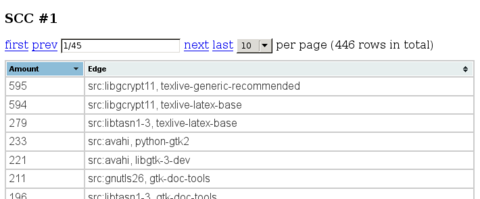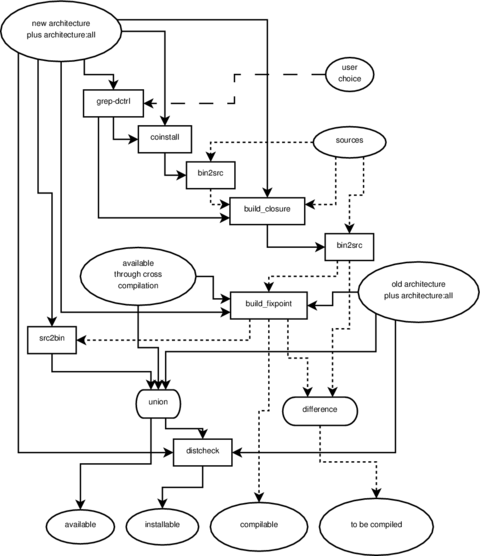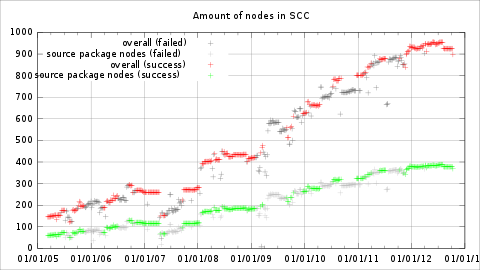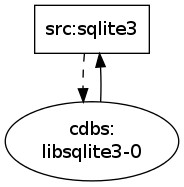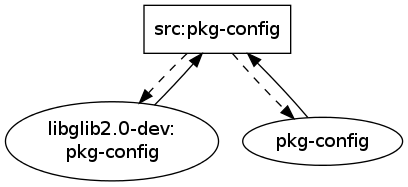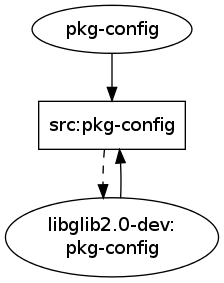 Sisyphus
Sisyphus is a piece of software that I
wrote as a member of a team from Jacobs University led by Prof. Dr. Andreas
N chter. It managed to place our team first in this year's
IEEE ICRA
2012 Virtual Manufacturing Automation
Competition in all three rounds.
The goal was, to stack a given set of boxes of different length, height and
width on a pallet in a way that achieved optimal volume utilization, center of
mass and interlock of the boxes. Besides the cartesian placement of a box on
the pallet, the only other degree of freedom was a 90 rotation of the box
around a vertical axis.
Since the arrangement of boxes into a three dimensional container is NP hard
(three dimensional orthogonal knapsack), I decided for a heuristic for an
approximate solution.
The premise is, that there are many boxes of equal height which was the case in
the
test cases that were available
from the 2011 VMAC.
Given this premise, my heuristic was, to arrange the boxes into layers of equal
height and then stack these layers on top of each other. A set of boxes that
would be left over or too little from the start to form its own full layer,
would then be stacked on the top of the completed layers.
There is a video of how this looked like.
My code is now
online on github and it
even documented for everybody who is not me (or a potential future me of
course).
This blog post is about the "interesting" parts of sisyphus. You can read about
the overall workings of it in the project's README.
Python dict to XML and XML to Python dict
The evaluation program for the challenge is reading XML files and the pallet
size and the list of articles with their sizes are also given in XML format. So
I had to have a way to easily read article information from XML and to easily
dump my data into XML format.
Luckily, all the XML involved was not making use of XML attributes at all, so
the only children a node had, where other nodes. Thus, the whole XML file could
be represented as an XML dictionary with keys being tagnames and the values
being other dictionaries or lists or strings or integers.
The code doing that uses
xml.etree.ElementTree and turns out to be very
simple:
from xml.etree import ElementTree
def xmltodict(element):
def xmltodict_handler(parent_element):
result = dict()
for element in parent_element:
if len(element):
obj = xmltodict_handler(element)
else:
obj = element.text
if result.get(element.tag):
if hasattr(result[element.tag], "append"):
result[element.tag].append(obj)
else:
result[element.tag] = [result[element.tag], obj]
else:
result[element.tag] = obj
return result
return element.tag: xmltodict_handler(element)
def dicttoxml(element):
def dicttoxml_handler(result, key, value):
if isinstance(value, list):
for e in value:
dicttoxml_handler(result, key, e)
elif isinstance(value, basestring):
elem = ElementTree.Element(key)
elem.text = value
result.append(elem)
elif isinstance(value, int) or isinstance(value, float):
elem = ElementTree.Element(key)
elem.text = str(value)
result.append(elem)
elif value is None:
result.append(ElementTree.Element(key))
else:
res = ElementTree.Element(key)
for k, v in value.items():
dicttoxml_handler(res, k, v)
result.append(res)
result = ElementTree.Element(element.keys()[0])
for key, value in element[element.keys()[0]].items():
dicttoxml_handler(result, key, value)
return result
def xmlfiletodict(filename):
return xmltodict(ElementTree.parse(filename).getroot())
def dicttoxmlfile(element, filename):
ElementTree.ElementTree(dicttoxml(element)).write(filename)
def xmlstringtodict(xmlstring):
return xmltodict(ElementTree.fromstring(xmlstring))
def dicttoxmlstring(element):
return ElementTree.tostring(dicttoxml(element))
Lets try this out:
>>> from util import xmlstringtodict, dicttoxmlstring
>>> xmlstring = "<foo><bar>foobar</bar><baz><a>1</a><a>2</a></baz></foo>"
>>> xmldict = xmlstringtodict(xmlstring)
>>> print xmldict
'foo': 'baz': 'a': ['1', '2'] , 'bar': 'foobar'
>>> dicttoxmlstring(xmldict)
'<foo><baz><a>1</a><a>2</a></baz><bar>foobar</bar></foo>'
The dict container doesnt preserve order, but as XML doesnt require that, this
is also not an issue.
Arranging items in layers
When it was decided, that I wanted to take the layered approach, it boiled down
the 3D knapsack problem to a 2D knapsack problem. The problem statement now
was: how to best fit small rectangles into a big rectangle?
I decided for a simple and fast approach as it is explained in Jake Gordon's
blog article. There is
a demo of his
code and should the site vanish from the net, the code is
on
github. This solution seemed to
generate results that were "good enough" while simple to implement and fast to
execute. If you look very hard, you can still see some design similarities
between my
arrange_spread.py and his
packer.js code.
Jake Gordon got his idea from Jim Scott who wrote an
article of arranging
randomly sized lightmaps into a bigger texture.
There is also an ActiveState Code
recipe from 2005 which looks
very similar to the code by Jake Gordon.
The posts of Jake Gordon and Jim Scott explain the solution well, so that I
dont have to repeat it. Should the above resources go offline, I made backups
of them
here
and
here.
There is also a backup of the ActiveState piece
here.
Spreading items out
The algorithm above would cram all rectangles into a top-left position. As a
result, there would mostly be space at the bottom and left edge of the
available pallet surface. This is bad for two reasons:
- the mass is distributed unequally
- articles on the layer above at the bottom or left edge, are prone to overhang too much so that they tumble down
Instead all articles should be spread over the available pallet area, creating
small gaps between them instead big spaces at the pallet borders.
Since articles were of different size, it was not clear to me from the start
what "equal distribution" would even mean because it was obvious that it was
not as simple as making the space between all rectangles equal. The spacing had
to be different between them to accommodate for differently sized boxes.
The solution I came up with, made use of the tree structure, that was built by
the algorithm that arranged the rectangles in the first place. The idea is, to
spread articles vertically first, recursively starting with the deepest nodes
and spreading them out in their parent rectangle. And then spreading them
horizontally, spreading the upper nodes first, recursively resizing and
spreading child nodes.
The whole recursion idea created problems of its own. One of the nicest
recursive beauty is the following function:
def get_max_horiz_nodes(node):
if node is None or not node['article']:
return [], []
elif node['down'] and node['down']['article']:
rightbranch, sr = get_max_horiz_nodes(node['right'])
rightbranch = [node] + rightbranch
downbranch, sd = get_max_horiz_nodes(node['down'])
ar = rightbranch[len(rightbranch)-1]['article']
ad = downbranch[len(downbranch)-1]['article']
if ar['x']+ar['width'] > ad['x']+ad['width']:
return rightbranch, sr+[downbranch[0]]
else:
return downbranch, sd+[rightbranch[0]]
else:
rightbranch, short = get_max_horiz_nodes(node['right'])
return [node] + rightbranch, short
get_max_horiz_nodes() traverses all branches of the tree that
node has
below itself and returns a tuple containing the list of nodes that form the
branch that stretches out widest plus the list of nodes that are in the other
branches (which are shorter than the widest).
Another interesting problem was, how to decide on the gap between articles.
This was interesting because the number resulting of the subtraction of the
available length (or width) and the sum of the articles lengths (or widths),
was mostly not divisible by the amount of gaps without leaving a rest. So there
had to be an algorithm that gives me a list of integers, neither of them
differing by more than one to any other, that when summed up, would give me the
total amount of empty space. Or in other words: how to divide a number m into n
integer pieces such that each of those integers doesnt differ more than 1 from
any other.
Surprisingly, generating this list doesnt contain any complex loop constructs:
>>> m = 108 # total amount
>>> n = 7 # number of pieces
>>> d,e = divmod(m, n)
>>> pieces = (e)*[(d+1)]+(n-e)*[d]
>>> print pieces
[16, 16, 16, 15, 15, 15, 15]
>>> sum(pieces) == m
True
>>> len(pieces) == n
True
You can test out the algorithms that arrange rectangles and spread them out by
cloning
the git and then running:
PYTHONPATH=. python legacy/arrange_spread.py
The results will be svg files test1.svg and test2.svg, the latter showing the
spread-out result.
Here is an example how the output looks like (without the red border which is
drawn to mark the pallet border):
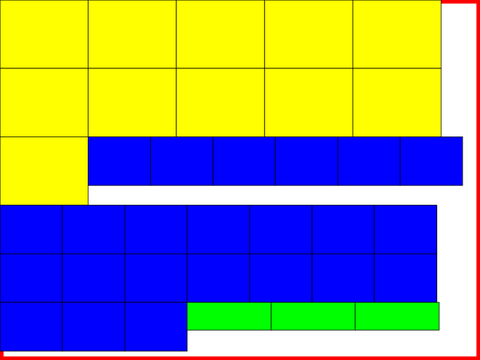

arrange_spread2.py contains an adaption of arrange_spread.py for the actual
problem.
Permutations without known length
When creating a layer out of articles of same height, then there are four
strategies that I can choose from. It is four because there are two methods
that I can either use or not. I can rotate the article by 90 per default or
not and I can rotate the pallet or not.
So every time that I build a new layer, there are those four options. Depending
on which strategy I choose, there is a different amount of possible leftover
articles that did not fit into any layer. The amount is different because each
strategy is more or less efficient.
To try out all combinations of possible layer arrangements, I have to walk
through a tree where at each node I branch four times for each individual
strategy. Individual neighboring nodes might be the same but this outcome is
unlikely due to the path leading to those neighboring nodes being different.
To simplify, lets name the four possible strategies for each layers 0, 1, 2 and
3. I now want an algorithm that enumerates through all possible permutations of
those four numbers for "some" length. This is similar to counting. And the
itertools module comes with the
product() method that nearly does what I
want. For example, should I know that my tree does not become deeper than 8
(read: no more than eight layers will be built), then I can just run:
>>> for i in itertools.product([0,1,2,3], repeat=8):
... print i
...
(0,0,0,0,0,0,0,0)
(0,0,0,0,0,0,0,1)
(0,0,0,0,0,0,0,2)
(0,0,0,0,0,0,0,3)
(0,0,0,0,0,0,1,0)
(0,0,0,0,0,0,1,1)
(0,0,0,0,0,0,1,2)
(0,0,0,0,0,0,1,3)
This would work if the number of layers created with each strategy was the
same. But as each strategy behaves differently depending on the input, it
cannot be known before actually trying out a sequence of strategies, how many
layers it will yield.
The strategy (0,0,0,0,0,0,0,0) might create 7 layers, resulting in
(0,0,0,0,0,0,0,1), (0,0,0,0,0,0,0,2) and (0,0,0,0,0,0,0,3) yielding the same
output as only the first 7 strategies count. This would create duplicates which
I should not waste cpu cycles on later.
It might also be that (0,0,0,0,0,0,1,0) turns out to be a combination of
strategies that creates more than 8 layers in which case the whole thing fails.
So what I need is a generator, that gives me a new strategy depending on how
often it is asked for one. It should dynamically extend the tree of possible
permutations to accommodate for any size.
Since the tree will become humongous (4^11 = 4194304), already traversed nodes
should automatically be cleaned so that only the nodes that make the current
list of strategies stays in memory at any point in time.
This sounded all complicated which made me even more surprised by how simple
the solution was in the end.
Here a version of the algorithm that could easily be ported to C:
class Tree:
def __init__(self, branch_factor):
self.branch_factor = branch_factor
self.root = "value": None, "parent": None, "children": []
self.current = self.root
def next(self):
if not self.current["children"]:
self.current["children"] = [ "value":val, "parent":self.current, "children":[] for val in range(self.branch_factor)]
self.current = self.current["children"][0]
return self.current["value"]
def reset(self):
if self.current["parent"]:
self.current["parent"]["children"].pop(0)
else:
return False
if self.current["parent"]["children"]:
self.current = self.root
return True
else:
self.current = self.current["parent"]
return self.reset()
def __str__(self):
return str(self.root)
It would be used like this:
>>> tree = Tree(4)
>>> print tree.next(), tree.next(), tree.next()
>>> while tree.reset():
... print tree.next(), tree.next(), tree.next()
Which would be equivalent to calling
itertools.product([1,2,3,4], 3). The
special part is, that in each iteration of the loop I can call
tree.next() an
arbitrary amount of times, just how much it is needed. Whenever I cannot
generate an additional layer anymore, I can call
tree.reset() to start a new
permutation.
For my code I used a python specific version which is a generator:
def product_varlength(branch_factor):
root = "value": None, "parent": None, "children": []
current = root
while True:
if not current["children"]:
current["children"] = [ "value":val, "parent":current, "children":[] for val in range(branch_factor)]
current = current["children"][0]
if (yield current["value"]):
while True:
if current["parent"]:
current["parent"]["children"].pop(0)
else:
return
if current["parent"]["children"]:
current = root
break
else:
current = current["parent"]
It is used like this:
it = product_varlength(4)
print it.next(), it.send(False), it.send(False)
while True:
print it.send(True), it.send(False), it.send(False)
Again, the expression in the loop can have any number of
it.send(False). The
first
it.send(True) tells the generator to do a reset.
 The task: reliably synchronize my local MailDir with several remote IMAP
mailboxes with IDLE support so that there is no need to poll with small time
intervals to get new email immediately.
Most graphical mail clients like icedove/thunderbird or evolution have IDLE
support which means that their users get notified about new email as soon as it
arrives. I prefer to handle email fetching/reading/sending using separate
programs so after having used icedove for a long time, I switched to a
offlineimap/mutt based setup a few years ago. Some
while after that I discovered sup and later
notmuch/alot which
made me switch again. Now my only remaining problem is the synchronization
between my local email and several remote IMAP servers.
Using offlineimap worked fine in the beginning but soon I discovered some of
its shortcomings. It would for example sometimes lock up or simply crash when I
switched between different wireless networks or switched to ethernet or UMTS.
Crashing was not a big problem as I just put it into a script which re-executed
it every time it crashed. The problem was it locking up for one of its
synchronizing email accounts while the others were kept in sync as usual. This
once let to me missing five days of email because offlineimap was not crashing
and I believed everything was fine (new messages from the other accounts were
scrolling by as usual) while people were sending me worried emails whether I
was okay or if something bad had happened. I nearly missed a paper submission
deadline and another administrative deadline due to this. This was insanely
annoying. It turned out that other mail synchronization programs suffered from
the same lockup problem so I stuck with offlineimap and instead executed it as:
The task: reliably synchronize my local MailDir with several remote IMAP
mailboxes with IDLE support so that there is no need to poll with small time
intervals to get new email immediately.
Most graphical mail clients like icedove/thunderbird or evolution have IDLE
support which means that their users get notified about new email as soon as it
arrives. I prefer to handle email fetching/reading/sending using separate
programs so after having used icedove for a long time, I switched to a
offlineimap/mutt based setup a few years ago. Some
while after that I discovered sup and later
notmuch/alot which
made me switch again. Now my only remaining problem is the synchronization
between my local email and several remote IMAP servers.
Using offlineimap worked fine in the beginning but soon I discovered some of
its shortcomings. It would for example sometimes lock up or simply crash when I
switched between different wireless networks or switched to ethernet or UMTS.
Crashing was not a big problem as I just put it into a script which re-executed
it every time it crashed. The problem was it locking up for one of its
synchronizing email accounts while the others were kept in sync as usual. This
once let to me missing five days of email because offlineimap was not crashing
and I believed everything was fine (new messages from the other accounts were
scrolling by as usual) while people were sending me worried emails whether I
was okay or if something bad had happened. I nearly missed a paper submission
deadline and another administrative deadline due to this. This was insanely
annoying. It turned out that other mail synchronization programs suffered from
the same lockup problem so I stuck with offlineimap and instead executed it as:
